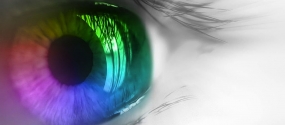I have written quite a bit on the differences between Lasik and PRK (Primer on PRK vs Lasik and Lasik vs PRK: What the Lasik Doctor Doesn’t Tell You – Short story: Run screaming from Lasik, it’s dodgy as hell, the very definition of a ‘quick-fix’), and I’ve written about my own PRK experiences (My Laser Eye Surgery, Part I: PRK Pre-Op Preparation, My Laser Eye Surgery, Part II: The PRK Operation, My Laser Eye Surgery, Part III: PRK Post-Op Recovery), but I haven’t yet spoken much about my own side-effects from my laser eye surgery.
Six-plus years after surgery, I’m still incredibly happy with both the recovery and with the results (vision I think is still better than 20/20, but as I age it’s naturally deteriorating). I have suffered (and still ‘suffer’) one side-effect: haloing. Halos can occur regardless of whether you’ve gotten Lasik, which cuts a flap in the cornea (never get Lasik!), or PRK/Epi-Lasik/Lasek (note the e in Lasek), which do not cut flaps in the cornea.
What is Haloing?
Haloing is an effect where your pupil opens wider than your corrected zone on your cornea (effectively a lens carved into the cornea itself). The image hitting your eye is simultaneously well-corrected and uncorrected. This results in an faint (typically less uncorrected light is getting through) overlapping blur, often with a starburst-like effect.
For me, before surgery, I would look at lights in the city night sky and see some form of haloing even with my contacts and glasses. I researched what it could look like and compared with what I was already getting. Hopefully the reader can make the same decision process.
I knew going into my surgery that my absolute widest pupil diameter was about 8-8.5mm. I measured my own in a *completely* dark room using a camera with a flash that would bounce off the ceiling and capture the pupils at the instant before they reacted to the flash. My laser doc measured my pupils in a semi-dark room and got about 6.5mm.
I knew that the system’s true correction zone (ignore any taper zone, that’s worthless, as I’ve written about in my Pre-Op Preparation article) was about 6-6.5mm, so I knew that I was going to be susceptible to haloing under very dark conditions. And I am, and will be forever. Unless I get my eyes done again in later years after my vision naturally deteriorates (and assuming these future machines have wider treatment zones).
In my case, I have say 6-6.5mm of great corrected vision, but a donut-shape of another 2mm of uncorrected vision. So in very dark conditions (and only in very dark conditions) I will get 70-80% of the light entering my eye and hitting my retina being corrected perfectly, but overlapping that, 20-30% of the light will be blurry, virtually the same blurriness as it was before my surgery.
This results in excellent vision of objects, with a faint after-image. But only when haloing will occur.
When Does Haloing Occur?
In practice, I only notice it when there is a rather bright object in a very dark setting. When the setting is very dark (driving at night in the country), but the object is not bright enough (pretty much everything except headlights and retroreflector cat-eyes on signs/road/etc), the halo is too faint to see, it’s below my visual acuity. And when the setting is bright enough (driving in the city), the ambient light from orange streetlights is more than enough to contract my pupil to 6-6.5mm (still quite wide), and all the light hitting my retina is corrected, so there are no halos.
I really only notice it in the countryside. Very bright stars have halos, but fainter ones do not (their halos are too faint to detect). Cat-eyes on the side of the road and reflective signs in the distance (small size) have halos, but large size signs or the moon do not (maybe because their size and brightness contracts my pupils?).
And I can make all the halos go away if I turn on the map-light in my car. It’s a fairly dim light, shining only on the dark console between the seats, but that’s just enough ambient light to contract my pupils. I can actually play with it. A distant road sign will have a halo, and when I increase/decrease the brightness in the car just enough, I can watch the halo shrink/increase as my pupil contracts/dilates.
Anyway, it’s interesting. But not really disturbing. I’d prefer not to have it, but I haven’t actually changed my behaviour any way. I don’t drive with any lights on in the car cabin (even though the light is still quite faint, just enough to have my pupils go from Extremely Wide to Very Wide). It simply never bothers me enough to bother about it. It’s kind of interesting though.
How Likely are Halos
From what I understand, the best laser systems as of this writing (2017) offer a true treatment zone with correction (ignoring taper zones) of about 6-6.5mm. And since typical human pupils can expand to around 8mm in very dark conditions, some degree of haloing is fairly likely to occur in most people who undergo laser eye surgery. However, that does not mean that all haloing is considered equal, or that each person will experience halos under the same lighting conditions. Slight changes in pupillary response can dramatically increase the frequency of haloing.
Should I Worry about Halos?
Absolutely. If you think about it, how your pupils react to different lighting conditions, and how bad your prescription was before surgery will both have a big effect on your haloing.
If your pupils go Extremely Wide (beyond the treatment zone, ignoring taper, etc) under relatively lighter ambient lighting situations (say driving at night in the city), then you’re going to experience haloing much more frequently. If I saw halos on every bright object (remember only the bright objects have enough light for their 20-30% halo to even register) in the city, then I may not be happy about that. Some folks who undergo laser eye surgery, especially on machines that have smaller true treatment zones (broken record: taper zones mean nothing, ignore them), will experience halos even under fairly bright ambient lighting conditions, like city driving at night.
There’s a big difference there. If you only experience haloing when it’s very dark, you’re going to experience very few cases where there is a bright enough light to halo that triggers one. However, if you experience haloing (if your pupils expand beyond the treatment zone) when it’s not completely dark, like in a city, then there are going to be LOTS of bright lights creating that ambient light, and you’re going to experience a lot of haloing.
Uncorrected vision before surgery will also affect how large the halos are. If, before surgery, the light causing the halo would have been only slightly enlarged from blurring, the faint haloing will only be as large as that after-surgery (under halo lighting conditions). But if your vision was so poor that oncoming headlights would have been blurred out to the size covering half your vision, then that diffusion of the light through your uncorrected cornea will still enter the eye. It will likely be fainter, but could be very large.
Summary
It’s essential to know what your true treatment zone (the fully-corrected, non-tapered treatment zone) will be. And it’s important to know how wide your pupils get in dark and semi-dark conditions.
I knew before my surgery that my eyes would expand wider than my treatment zone under very dark conditions, but that my pupils were not wider than the treatment zone under moderately dark conditions. I was okay with this, understanding when I would see halos and when I would not.
To be honest, as with all aspects of laser eye surgery I discuss on here, I’d prefer if the surgeon gave all the information on the topic that a prospective patient would need to make an informed decision. I understand that many prefer not to know all the nitty-gritty details, and would prefer to go into the surgery with their eyes closed (ha!). That’s obviously not me. And I’m assuming that’s not you.
That said, I understand why the doctors typically measure your pupil in a ‘mostly dark’ room. That more closely simulates the environments you’d be most annoyed if you had haloing. It’s not often that we are in extremely dark settings that have very bright lights. Driving at night in the dark countryside is one of them. And even then, at least for me, it’s more of a science experiment than an inconvenience.
Of course each prospective patient is going to have to ask their own questions, get their own answers from their doctors, and come to their own decision about haloing. About all aspects of the surgery.
Good luck, and keep me posted on your journey!
Continued Reading
Here are my posts on PRK and laser eye surgery, continue reading or, feel free to join the discussion in the comments below!
Laser Eye Surgery Primer: Lasik vs PRK
Lasik vs PRK: What the Lasik Doctor Doesn’t Tell You
My Laser Eye Surgery, Part I: PRK Pre-Op Preparation
My Laser Eye Surgery, Part II: The PRK Operation
My Laser Eye Surgery, Part III: PRK Post-Op Recovery
Halos: A Likely Complication of PRK or Lasik (You are Here)
More Information







Hello, Mr. Temple:
Thank you so much for all the valuable information on PRK.
You’ve really done your homework. ;)
Have you have heard of these procedures,
KAMRA Inlay and ReLEx SMILE?
If so, your thoughts, please.
Cheers!
Greetings…great set articles. Best I’ve seen by far. Especially post op re drops and tin foil on windows! The glare in photo above looks just like what I have…PRE PRK. Mainly due to cataract lens replacement.
My same Question I posted in other pre-op post, but this halo article is better fit. I have some glare and halos from post cataract surgery, July 2017. My Tecnis Z9002 lens size was 6mm. (I don’t know dark pupil size.)
Z9002 is of course behind the cornea; but is that sizing relative to my pupil size causing halos? Nobody seems to know.
Worse is night single point lights, IE headlights I have halo about 6-10 feet radius. Also pnkish orange street lights have huge 20-30 ft halos. Glare from florescent lights is annoying too.
I have planned for some touch up PRK due to over correction in cataract lens RX. Correction is about +0.75.
Can the PRK correct halo from cataract lens?
Best from Colorado